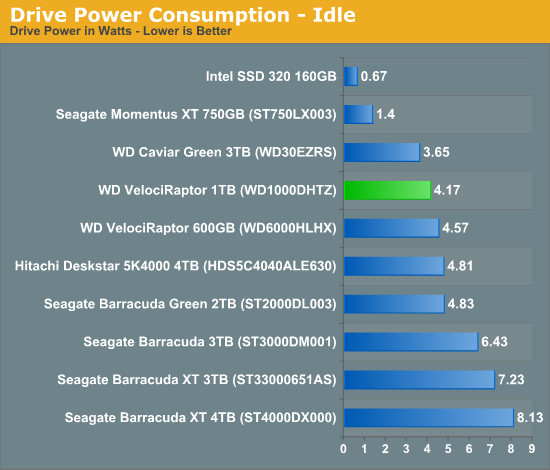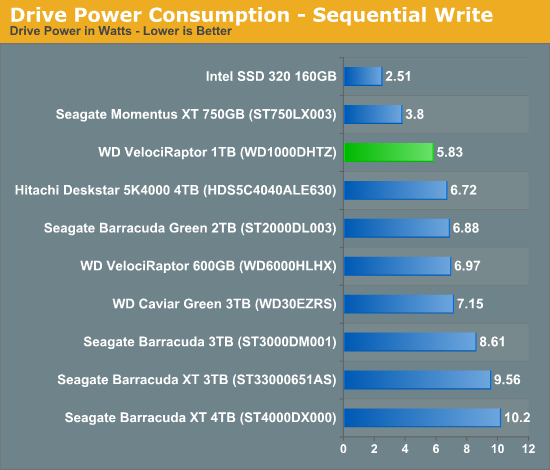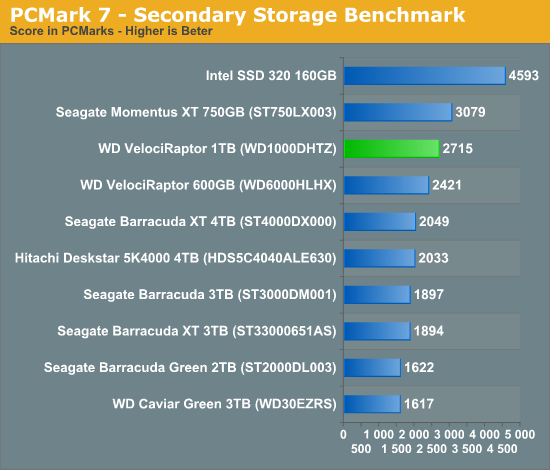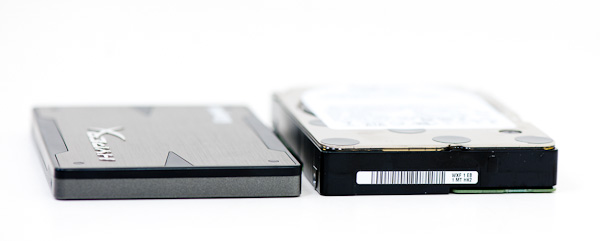Western Digital VelociRaptor 1TB (WD1000DHTZ) Review
by Anand Lal Shimpi on April 16, 2012 8:00 AM EST- Posted in
- Storage
- HDDs
- Western Digital
- VelociRaptor
PCMark 7 Performance
For workloads that are particularly read intensive and small enough to make good use of the on-board NAND, the Momentus XT cannot be beat. The VelociRaptor does come very close however, and it does win in enough other benchmarks to make it clearly the better overall performer. Philosophically I understand why Western Digital opted against equipping the VR with any NAND (cached operations do sort of defeat the purpose of having a 10,000 RPM spindle speed), but that doesn't change the fact that it would've made for one pretty impressive hard drive.
Power Consumption
Despite its 2.5" form factor (the drive itself), the VelociRaptor's 15mm height prevented it from being used as a notebook drive. Even if you had a thick enough notebook, the VR's power consumption is more in-line with a 5400RPM 3.5" drive than a standard 2.5" mobile drive. That being said, as a 10,000RPM 3.5" drive the VelociRaptor is quite power efficient. Idle power is competitive with WD's Caviar Green (and lower in the case of load power).
Power consumption is down compared to the previous generation as well. Once again, compared to an SSD however the drive isn't anywhere near efficient.














92 Comments
View All Comments
Stuka87 - Monday, April 16, 2012 - link
Seagate would disagree. As they Hybrid drives are nearly as fast as an SSD but have a terabyte of storage.kmmatney - Monday, April 16, 2012 - link
I'm pretty surprised at how far behind the Seagate Momentus XT is in these benchmarks, though. This review doesn't make the Seagate look very good at all.exordis - Monday, April 16, 2012 - link
IIRC from the Momentus XT review it's performance on the first run through of a given benchmark was basically the same as any other HDD of the same specs. Because of the way it learns common tasks and caches the things you do often it requires a couple of runs of a given task before it's extra performance shows.Samus - Monday, April 16, 2012 - link
I not only disagree as well with Makaveli, but can't help but think what a failure it is on WD's part to ignore making this drive a hybrid like the Momentus XT.Remember, the Momentus XT isn't tweaked for performance, it's an extremely low power (5-watt) drive that needs to meet the cooling envelope of a laptop drivebay.
The Raptor doesn't have those restrictions. If this drive were paired with 8 or 16GB NAND, it would have been a monster, essentially a 1TB SSD for <$400.
The problem must be WD knows nothing about hybrid technology. They can't possibly be foolish enough to ignore the fact that SSD's are the future and hard disks can't survive by only having superior capacity and lower prices. They need to have high performance and reliability as well.
This launch is a complete disaster. This could have been exceptional if adapted to the times. A 10k performance-oriented drive using Hybrid-NAND technology could have been amazing.
kyuu - Tuesday, April 17, 2012 - link
/agreeThe only problem is that they'd have been starting from scratch with the caching algorithms and other things that go along with a hybrid HDD. Remember how much of a disaster Seagate's 1st gen hybrid HDDs were? Part of what makes the Momentus XT great is the experience Seagate has with the hybrid HDD platform, which no other manufacturer really has.
TeXWiller - Tuesday, April 17, 2012 - link
I'd prefer to keep those SSD caches directly attached to the PCIe bus and have a more knowledgeable operating system.The reliability numbers are quite good, so on paper this would be the most reliable 1 TB consumer oriented rotating hard drive. This way the launch is not a disaster as drives with equivalent theoretical reliability are hard, or much more expensive to buy from the online store near you.
Samus - Tuesday, April 17, 2012 - link
I've replaced a number of Raptors through almost every generation in mail servers and SQL servers that receive a lot of constant traffic within warranty.That would never happen with an SSD, where you can do 20GB/day for 5+ years.
mercutiouk - Tuesday, April 17, 2012 - link
One thing you COULD do with this is throw it in the intel rapid storage raid 5 setup. Sit the fastest 40GB SSD you can find (or a partition of a larger SSD of course) with 4 of these behind it.While not cheap (you'd need to drop about 1k on your storage alone) you'd be looking at 3TB of "rather quick" storage that could suffer a drive failure and keep things together.
4x 200MB sustained (so about 550/600MB once the raid 5 etc has dampened performance a bit) with an SSD doing all the responsive bits of access the raid had to deal with would make an impressive setup.
I run a hardware raid-5 with an SSD for boot at the moment and it's rather nice for most things.
GreenEnergy - Monday, April 16, 2012 - link
Microsoft actually got a fine picture on my HDs are such a huge bottleneck in todays PCs.http://blogs.msdn.com/blogfiles/e7/WindowsLiveWrit...
glasspelican - Monday, April 16, 2012 - link
I am supprised that thy dont have any flash on this drive. I got the momnentus xt in my laptop and it makes a huge difference